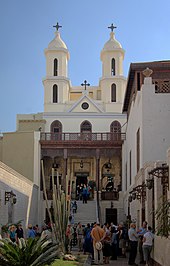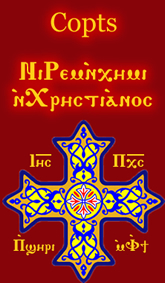Coptic Cairo


Coptic Cairo is a part of Old Cairo which encompasses the Babylon Fortress, the Coptic Museum, the Hanging Church, the Greek Church of St. George and many other Coptic churches and historical sites. It is believed in Christian tradition that the Holy Family visited this area and stayed at the site of Saints Sergius and Bacchus Church (Abu Serga).[1] Coptic Cairo was a stronghold for Christianity in Egypt both before and during the Islamic era, as most of its churches were built after the Muslim conquest of Egypt in the 7th century.
History[]
There is evidence of settlement in the area as early as the 6th century BC, when Persians built a fort on the Nile, north of Memphis. The Persians also built a canal from the Nile (at Fustat) to the Red Sea. The Persian settlement was called Babylon, reminiscent of the ancient city along the Euphrates, and it gained importance while the nearby city of Memphis declined, as did Heliopolis.[2] During the Ptolemaic period, Babylon and its people were mostly forgotten.[3]
It is traditionally held that the Holy Family visited the area during the Flight into Egypt, seeking refuge from Herod.[4] Further it is held that Christianity began to spread in Egypt when St. Mark arrived in Alexandria, becoming the first Patriarch, though the religion remained underground during the rule of the Romans.[5] As the local population began to organize towards a revolt, the Romans, recognising the strategic importance of the region, took over the fort and relocated it nearby as the Babylon Fortress.[6] Trajan reopened the canal to the Red Sea, bringing increased trade, though Egypt remained a backwater as far as the Romans were concerned.[5]
Under the Romans, St. Mark and his successors were able to convert a substantial portion of the population, from pagan beliefs to Christianity. As the Christian communities in Egypt grew, they were subjected to persecution by the Romans, under Emperor Diocletian around 300 AD, and the persecution continued following the Edict of Milan that declared religious toleration. The Coptic Church later separated from the church of the Romans and the Byzantines. Under the rule of Arcadius (395-408), a number of churches were built in Old Cairo.[7] In the early years of Arab rule, the Copts were allowed to build several churches within the old fortress area of Old Cairo.[8]
The Ben Ezra Synagogue was established in Coptic Cairo in 1115, in what was previously a Coptic church that was built in the 8th century. The Copts needed to sell it, in order to raise funds to pay taxes to Ibn Tulun.[9]
In the 11th century AD, Coptic Cairo hosted the Seat of the Coptic Orthodox Pope of Alexandria, which is historically based in Alexandria. As the ruling powers moved from Alexandria to Cairo after the Arab invasion of Egypt during Pope Christodolos's tenure, Cairo became the fixed and official residence of the Coptic Pope at the Hanging Church in Coptic Cairo in 1047.
The Coptic Museum was established in 1910, and it houses the world's most important examples of Coptic art.[10][11]
Churches[]
Coptic Cairo is, to this day, a predominantly Christian area,[12] hosting many historically important churches:
| Part of a series on the |
| Copts |
|---|
| Culture |
|
| Regions |
| Denominations |
|
| Language |
| Writing systems |
- Saint Mary Church (Haret Elroum)
- Saint Mercurius Church
- Saints Sergius and Bacchus Church (Abu Serga)
- The Hanging Church
- Church of the Holy Virgin (Babylon El-Darag)
- Saint Barbara Church
- The Church of Saint Menas[1]
- Nunnery and Church of St. George (Cairo)
- Monastery and Church of St. George (Greek Orthodox)
See also[]
- Copts in Egypt
- Coptic Orthodox Church
- Coptic architecture
- Seat of the Coptic Orthodox Pope of Alexandria
- Saint Mark's Coptic Orthodox Cathedral, Cairo
- Saint Mark's Coptic Orthodox Cathedral (Alexandria)
- Church of the Virgin Mary (Haret Zuweila)
- Holy family in Egypt
- Ben Ezra Synagogue
Notes[]
- ^ a b Coptic Cairo egyptologyonline Archived 2007-12-14 at the Wayback Machine
- ^ Beattie 2005, p. 63
- ^ Beattie 2005, pp. 64–65
- ^ Beattie 2005, p. 65
- ^ a b Beattie 2005, p. 66
- ^ Yeomans, Richard (2006), The Art and Architecture of Islamic Cairo, Garnet & Ithaca Press, pp. 9, ISBN 1-85964-154-7
- ^ Kamil 1987, p. 81
- ^ Beattie 2005, pp. 67–69
- ^ Beattie 2005, pp. 84–85
- ^ Beattie 2005, pp. 75–76
- ^ Brief History, Coptic Museum, archived from the original on 2004-06-03, retrieved 2009-01-29
- ^ "Cairo travel". Archived from the original on 2008-07-09. Retrieved 2008-02-26.
References[]
- Beattie, Andrew (2005), Cairo: A Cultural History, Oxford University Press
- Kamil, Jill (1987), Coptic Egypt, American University in Cairo Press
External links[]
| Wikimedia Commons has media related to Coptic Cairo. |
Coordinates: 30°00′23″N 31°13′54″E / 30.00628°N 31.231781°E
- Districts of Cairo
- Coptic Cairo
- Coptic settlements
- Old Cairo
- Coptic history



